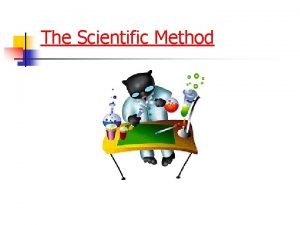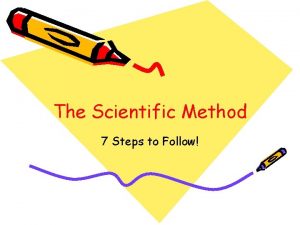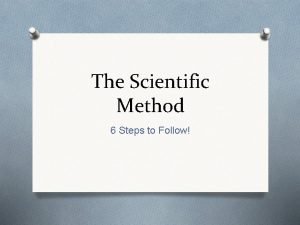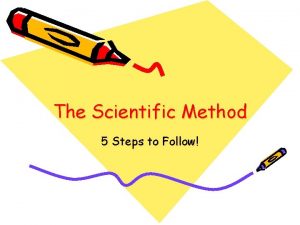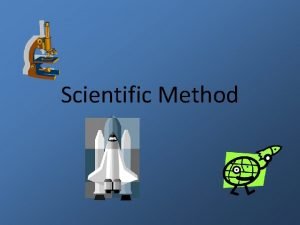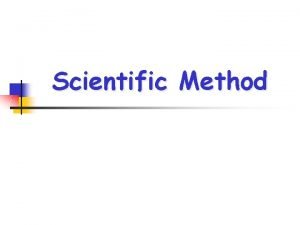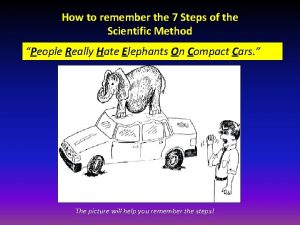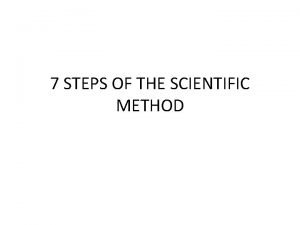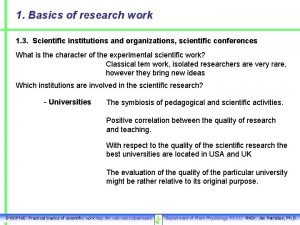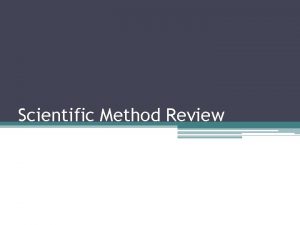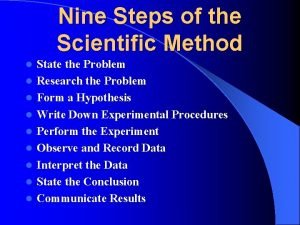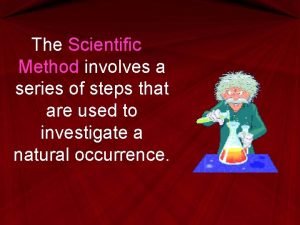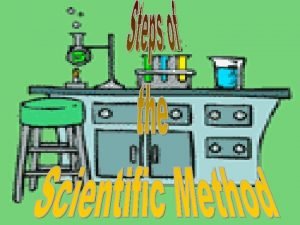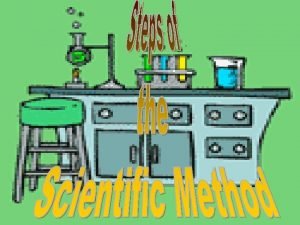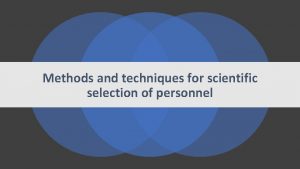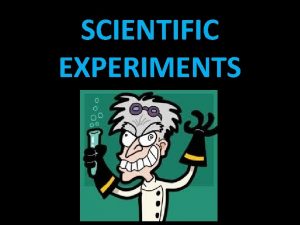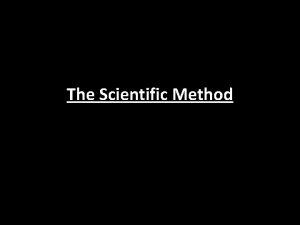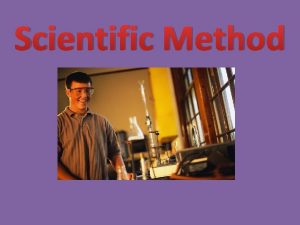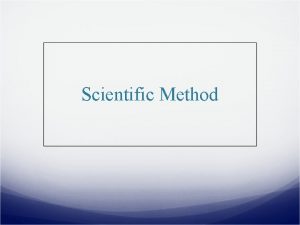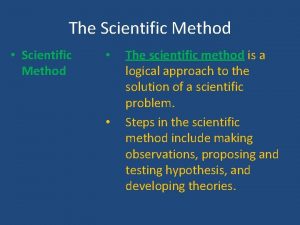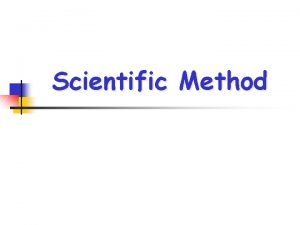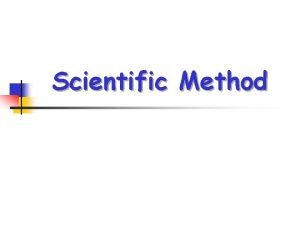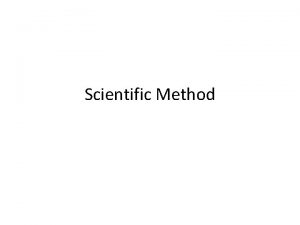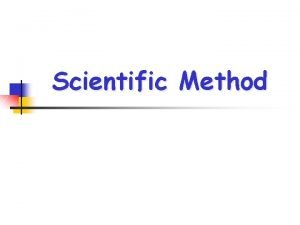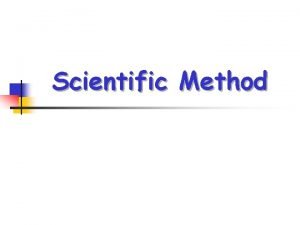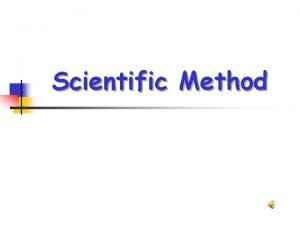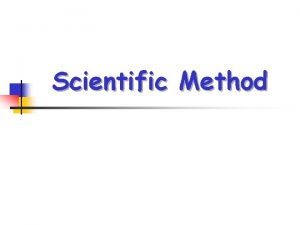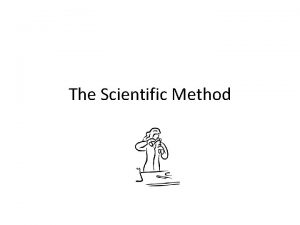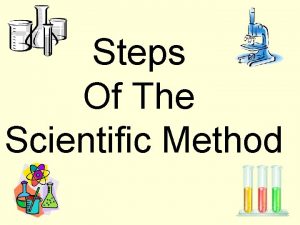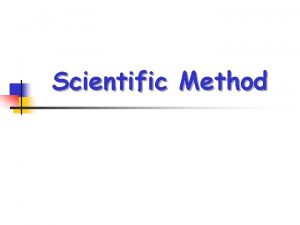Scientific Method Steps in the Scientific Method 1




























- Slides: 28

Scientific Method

Steps in the Scientific Method 1. Observation 2. Hypothesis 3. Experiment -Data Collection 4. Conclusion n Retest

1. Observations Gather Information through your senses n Usually in the form of a QUESTION

Observations n An example of an observation might be noticing that many salamanders near a pond have curved, not straight, tails

OBSERVATION n Why do some salamanders have curved tails but most have straight tails?

2. Hypothesis n n A suggested solution to the problem. (Educated guess) Must be testable Sometimes written as If…Then… statements Predicts an outcome

Hypothesis n An example of a hypothesis might be that the salamanders have curved tails due to a pollutant in the moist soil where they live.

Practice thinking like a scientists n n n A scientist notices the population of Bald Eagles has declined. He sets up a camera to watch the nest of a female Bald Eagle. He notices that when the female sits on her eggs to incubate them, the eggs crack (killing the developing baby bald eagles)

n n Think like a scientist to develop a hypothesis to explain this. Brainstorm with your group.


3. Experiment n A procedure to test the hypothesis.

Experiment Variable – factor in the experiment that is being tested

3 Types of Variables n n n 1. Control variables 2. Independent variables 3. dependent variables

Scientific Experiments Follow Rules n An experimenter changes one factor and observes or measures what happens.

The Control Variable n n The experimenter makes a special effort to keep other factors constant so that they will not effect the outcome. Those control factors are called variables.

What is the Purpose of a Control? n n Controls are NOT being tested Controls are used for COMPARISON

Other Variables n n The factor that is changed is known as the independent variable. (What You Change) The factor that is measured or observed is called the dependent variable. (What happens during the experiment)

Experiment A good or “valid” experiment will only have ONE (independent) variable!

Example of Controls & Variables n n n For example, suppose you want to figure out the fastest route to walk home from school. You will try several different routes and time how long it takes you to get home by each one. Since you are only interested in finding a route that is fastest for you, you will do the walking yourself.

What are the Variables in Your Experiment? Varying the route is the independent variable n The time it takes is the dependent variable n Keeping the same walker throughout makes the walker a control variable. n

One more thing… it is best to make several trials with each independent variable.

Valid Experiments

Data n Information n Collected during experiment n May be quantitative (numbers) or qualitative (characteristics)

Data Must be organized n Can be organized into charts, tables, or graphs n

Conclusion n The answer to the hypothesis based on the data obtained from the experiment

Retest In order to verify the results, experiments must be retested.

Review

Solving a Problem 1)Identify a Problem 2) State Observations about the problem 3) Form a Hypothesis about the problem (if…then…) 4) Design an Experiment to test the hypothesis 5) Collect Data 6) Form a Conclusion 7) Retest
 7 steps of the scientific method
7 steps of the scientific method 7 steps of the scientific method
7 steps of the scientific method What are the 7 steps of the scientific method
What are the 7 steps of the scientific method What are the 6 steps of the scientific method
What are the 6 steps of the scientific method The five steps of the scientific method
The five steps of the scientific method Importance of scientific method
Importance of scientific method Scientific method steps
Scientific method steps Scientific method steps
Scientific method steps 7 steps of the scientific method
7 steps of the scientific method What are the 7 steps of the scientific method
What are the 7 steps of the scientific method Steps of scientific method
Steps of scientific method What are the six steps of the scientific method
What are the six steps of the scientific method 9 steps in scientific method
9 steps in scientific method Scientific method steps
Scientific method steps Scientific method steps
Scientific method steps Scientific method steps
Scientific method steps Scientific method steps
Scientific method steps Scientific inquiry vs scientific method
Scientific inquiry vs scientific method Axial movement of the body examples
Axial movement of the body examples What is the conclusion in the scientific method
What is the conclusion in the scientific method Scientific selection of personnel
Scientific selection of personnel Hình ảnh bộ gõ cơ thể búng tay
Hình ảnh bộ gõ cơ thể búng tay Bổ thể
Bổ thể Tỉ lệ cơ thể trẻ em
Tỉ lệ cơ thể trẻ em Chó sói
Chó sói Tư thế worm breton
Tư thế worm breton Hát lên người ơi
Hát lên người ơi Môn thể thao bắt đầu bằng từ đua
Môn thể thao bắt đầu bằng từ đua
